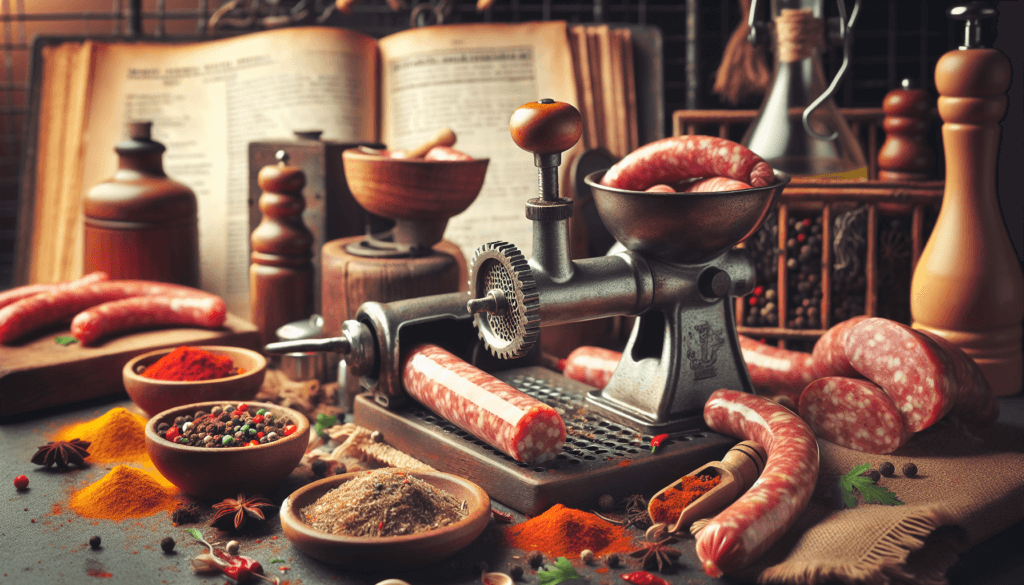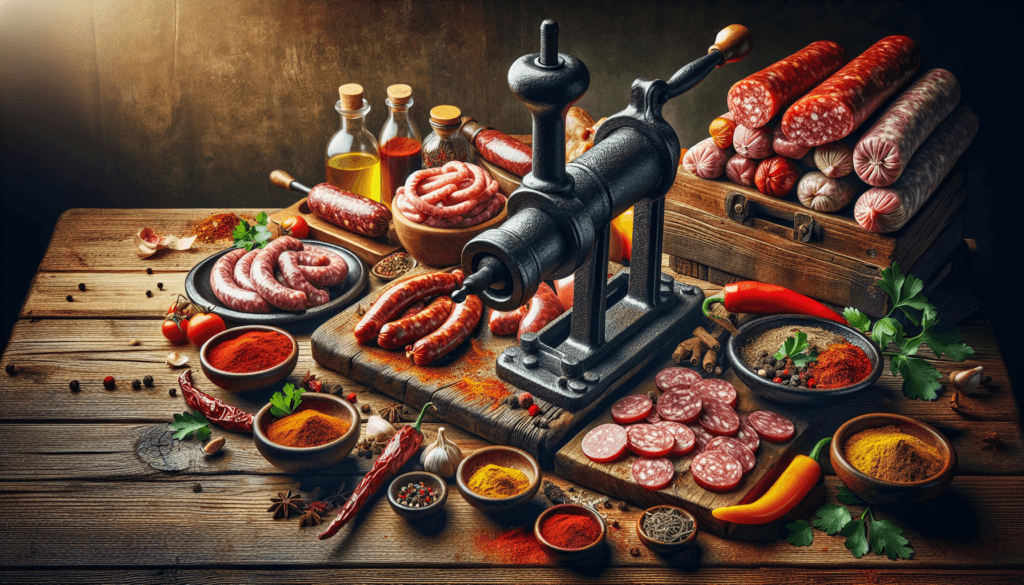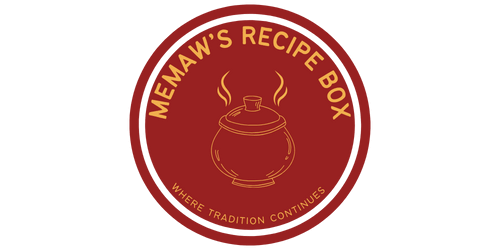If you’ve ever wondered how to make homemade sausages, you’re in for a treat. This article will explore the most popular methods for crafting delicious sausages from scratch. Whether you’re a seasoned chef or a novice in the kitchen, these techniques are sure to inspire you to try your hand at making your very own sausages. From traditional recipes to innovative twists, you’ll discover a variety of methods that will have you savoring the satisfaction of homemade sausages in no time. So, get ready to embark on a culinary adventure and unlock the secrets to creating mouthwatering sausages right in your own kitchen.
Curing Methods
Dry Curing
Dry curing is a traditional method of preserving meats that involves the use of salt and other dry ingredients. To dry cure sausage, you will need a mixture of salt, sugar, and various spices and seasonings. This mixture is then rubbed onto the surface of the meat and allowed to sit and cure for a specific period of time. Dry curing can take a few weeks or even months, depending on the desired flavor and texture. The process of dry curing helps to draw out moisture from the meat, which inhibits the growth of bacteria and contributes to the development of rich flavors.
Wet Curing
Wet curing, also known as brining, is a method that involves submerging the sausages in a solution of water, salt, sugar, and other flavorings. This curing method is often used for larger cuts of meat or sausages that require a shorter curing time. Wet curing helps to infuse the meat with flavors and moisture, resulting in a juicy and tender final product. The sausages are typically left to soak in the brine for a specific period of time, allowing the flavors to penetrate the meat before proceeding to the next steps of the sausage making process.
Brine Curing
Brine curing is a specific type of wet curing method that involves immersing the sausages in a saltwater solution known as a brine. The brine is made by dissolving salt, sugar, and other seasonings in water. The sausages are then submerged in the brine and left to soak for a predetermined amount of time. Brine curing is a popular method for making sausages as it imparts a distinct flavor and helps to preserve the meat. The brine adds moisture to the sausages, resulting in a juicy and flavorful end product.
Grinding and Mixing
Choosing the Meat
When it comes to making sausages, choosing the right meat is crucial. Opt for cuts of meat that have the right balance of lean meat and fat. The fat content is important as it contributes to the moistness and flavor of the sausage. Common choices include pork shoulder, beef chuck, and a combination of both. It is recommended to grind the meat yourself rather than purchasing pre-ground meat, as this allows for better control over the texture and consistency of the sausages.
Grinding the Meat
Grinding the meat is an essential step in the sausage making process. Use a meat grinder to grind the selected cuts of meat to the desired coarseness. The coarseness can vary depending on personal preference and the type of sausage you are making. Some sausages require a finer grind, while others benefit from a coarser grind. It is important to keep the meat and grinder attachments cold during this process to prevent the meat from heating up and affecting the overall texture of the sausages.
Adding Ingredients
Once the meat has been ground, it is time to add the various ingredients that will contribute to the flavor and texture of the sausages. This includes a wide range of spices, herbs, seasonings, and sometimes even fruits or vegetables. The ingredients can be adjusted according to personal taste preferences and the specific sausage recipe being followed. Be sure to mix the ingredients thoroughly to ensure even distribution throughout the meat.
Mixing the Ingredients
After adding the ingredients, the next step is to mix everything together. This can be done using your hands or a mixing spoon. The goal is to evenly incorporate the spices and seasonings into the meat mixture. Mixing also helps to develop the proteins within the meat, resulting in a better texture and binding of the ingredients. Take care not to overmix the mixture, as this can cause the proteins to become tough and result in a less enjoyable final product.

Stuffing and Casings
Natural Casings
Natural casings, typically made from the intestines of animals, are a popular choice for sausage making. These casings are flexible, durable, and contribute to the traditional appearance and texture of sausages. Natural casings can be purchased in various sizes, allowing you to create sausages of different thicknesses. Before using natural casings, they need to be soaked in water to soften and become pliable. This step helps in threading and stuffing the sausages.
Artificial Casings
Artificial casings are an alternative to natural casings and are typically made from cellulose or collagen. These casings are convenient to use, as they are pre-formed and do not require any soaking before stuffing. Artificial casings also provide a consistent shape and size to the sausages, resulting in a more uniform appearance. However, it is important to note that artificial casings do not have the same snap or texture as natural casings, so they may not provide the same authentic experience.
Stuffing the Sausage
Once the casings have been prepared, it is time to stuff the sausages. This can be done using a sausage stuffer or a sausage stuffing attachment for the meat grinder. Fill the casings with the meat mixture, taking care not to overstuff them as this can cause the casings to burst during cooking. It is important to work carefully and evenly, ensuring that there are no air pockets in the sausages. Twist the sausages periodically to separate them into individual links.
Smoking and Cooking
Hot Smoking
Hot smoking involves cooking the sausages at a temperature between 165°F (74°C) and 185°F (85°C) while exposing them to smoke from wood chips or pellets. This method gives the sausages a smoky flavor and cooks them to a safe internal temperature. The sausages are placed directly in the smoker and cooked until they reach the desired internal temperature. Hot smoking is a popular method for fully cooked sausages and can be done using a variety of wood types to achieve different flavors.
Cold Smoking
Cold smoking is a method that imparts a smoky flavor to sausages without fully cooking them. The sausages are exposed to the smoke of smoldering wood chips or pellets at a temperature below 100°F (38°C). Cold smoking is often done in a separate smoking chamber or with the use of special equipment to maintain a consistently low temperature. This method creates a smoky flavor while preserving the sausages’ texture and allowing for further cooking or heating before consumption.
Indirect Smoking
Indirect smoking is a technique that involves cooking the sausages using indirect heat and smoke. This is typically done in a barbecue grill or smoker. The sausages are placed away from the heat source and cooked slowly, allowing the smoke to flavor the meat. Indirect smoking is a versatile method that allows for the use of different wood types and charcoal for varying flavors. It is important to monitor the cooking temperature to ensure that the sausages are evenly cooked and reach the appropriate internal temperature.
Poaching
Poaching involves cooking the sausages in liquid at a gentle simmer. This method is often used for fresh sausages or sausages that have been previously smoked and need to be heated through. The sausages are placed in a pot or skillet with enough liquid to cover them, such as water, broth, beer, or wine. The liquid is heated to a simmer, and the sausages are cooked until they reach the desired internal temperature. Poaching helps to keep the sausages moist and infuse them with additional flavors.
Grilling
Grilling is a popular cooking method for sausages, as it imparts a charred and slightly smoky flavor. Preheat the grill to medium heat and place the sausages directly on the grates. Grill them for about 10-15 minutes, turning occasionally, until they are evenly browned and cooked through. It is important to monitor the sausages closely to prevent burning or charring. Grilling provides a quick and easy cooking method that results in juicy and flavorful sausages.
Pan-Frying
Pan-frying is a versatile cooking method that can be done on the stove using a skillet or frying pan. Heat a small amount of oil or butter in the pan over medium heat. Place the sausages in the pan and cook them for approximately 10-15 minutes, turning occasionally, until they are browned and cooked through. Pan-frying allows for precise control of the cooking temperature and can result in sausages with a crispy exterior and juicy interior.

Flavors and Seasonings
Herbs and Spices
Herbs and spices play a crucial role in adding flavor and depth to sausages. Common herbs and spices used in sausage making include oregano, thyme, sage, rosemary, fennel seeds, cayenne pepper, and black pepper. These ingredients can be adjusted based on personal preference and the specific flavor profile desired.
Salt
Salt is a key ingredient in sausage making as it helps to enhance flavors and preserve the meat. It is important to use the correct amount of salt based on the weight of the meat being used. Too little salt can result in bland-tasting sausages, while too much salt can lead to an unpleasantly salty flavor.
Sugar
Sugar is often added to sausages to balance out the flavors and add a touch of sweetness. Brown sugar, honey, or maple syrup are commonly used sweeteners in sausage recipes. The addition of sugar can help to enhance the overall taste of the sausages.
Garlic
Garlic is a popular ingredient in sausage making as it adds a distinct flavor and aroma. It can be used fresh, dried, or in the form of garlic powder. The amount of garlic added can be adjusted according to personal preference.
Onion
Onions are commonly used to add flavor and moisture to sausages. They can be sautéed or used in the form of onion powder. The addition of onions can provide a subtle sweetness and depth of flavor to the sausages.
Pepper
Pepper, both black and white, is a commonly used spice in sausage making. It adds a warming and slightly spicy flavor to the sausages. The amount of pepper can be adjusted based on personal preference.
Paprika
Paprika is a spice made from grinding dried peppers and adds a vibrant color and smoky flavor to sausages. It is often used in sausage recipes to enhance the overall appearance and taste.
Other Flavorings
There are numerous other flavorings that can be added to sausages, such as red wine, Worcestershire sauce, mustard, and various hot sauces. These ingredients can be used to create unique and customized flavors based on personal preference.
Sausage Varieties
Italian Sausage
Italian sausage is a popular and versatile sausage variety that is often used in pasta dishes, sandwiches, and as a pizza topping. It is typically seasoned with garlic, fennel seeds, and other Italian herbs and spices. Italian sausage can be mild or spicy, depending on the amount of red pepper flakes used.
Bratwurst
Bratwurst is a traditional German sausage that is made with a combination of pork and sometimes beef or veal. It is seasoned with a blend of spices such as coriander, nutmeg, and marjoram. Bratwurst is often grilled or pan-fried and served on a bun with sauerkraut and mustard.
Chorizo
Chorizo is a spicy and flavorful sausage that originates from Spain and Portugal. It is often made with a combination of pork and spices such as smoked paprika, garlic, and chili peppers. Chorizo can be used in a variety of dishes, including stews, tacos, and breakfast skillets.
Andouille
Andouille is a smoked sausage that is commonly used in Cajun and Creole cooking. It is made with pork and seasoned with spices such as paprika, garlic, and cayenne pepper. Andouille sausage adds a smoky and spicy flavor to dishes like jambalaya and gumbo.
Kielbasa
Kielbasa is a traditional Polish sausage that is made with pork, beef, or a combination of both. It is seasoned with garlic, marjoram, and black pepper. Kielbasa can be smoked or cooked fresh and is often served grilled or pan-fried.
Liverwurst
Liverwurst is a type of sausage that is made with pork liver, pork meat, and various seasonings. It has a rich and creamy texture and is often spread on bread or crackers. Liverwurst can be flavored with ingredients such as onions, garlic, and spices.
Boudin
Boudin is a Cajun sausage that is made with pork, rice, and various seasonings. It has a unique texture and flavor and is often steamed or boiled before being served. Boudin can be enjoyed on its own or used in dishes like jambalaya or gumbo.
Merguez
Merguez is a North African sausage that is typically made with lamb or beef. It is seasoned with spices such as cumin, coriander, and chili pepper. Merguez sausage is often grilled or pan-fried and served with couscous or in pita bread.
Cumberland Sausage
Cumberland sausage is a traditional British sausage that is made with pork, breadcrumbs, and a blend of spices including sage, thyme, and nutmeg. It has a distinctive coiled shape and is often served with gravy and mashed potatoes.
Breakfast Sausage
Breakfast sausage is a versatile sausage variety that is often enjoyed as part of a hearty breakfast. It is typically made with ground pork and seasoned with a blend of spices such as sage, thyme, and black pepper. Breakfast sausage can be formed into patties or links and cooked in various ways, such as pan-frying or baking.

Equipment and Tools
Meat Grinder
A meat grinder is an essential tool for making sausages at home. It allows you to grind the selected cuts of meat to the desired consistency, ensuring a smooth and even texture.
Sausage Stuffer
A sausage stuffer is used to fill the casings with the meat mixture. It can be a manual stuffer or an attachment for a meat grinder. A sausage stuffer ensures even and controlled filling of the casings.
Smoker
A smoker is used to cook and impart a smoky flavor to the sausages. It can be a charcoal, electric, or gas smoker, depending on personal preference.
Thermometer
A thermometer is crucial for ensuring that the sausages are cooked to a safe internal temperature. It helps to prevent undercooking or overcooking the sausages, resulting in a perfectly cooked end product.
Food Processor
A food processor can be used to finely chop or blend ingredients for the sausage mixture. It is especially helpful for making spice blends or incorporating fruits and vegetables into the sausages.
Mixing Bowl
A mixing bowl is necessary for combining the ground meat and ingredients. Choose a bowl that is large enough to accommodate the meat mixture and allows for easy mixing.
Knife
A sharp knife is essential for trimming the meat, cutting casings, and other preparation tasks. It is important to use a knife with a comfortable grip and a sharp blade for safety and efficiency.
Cutting Board
A cutting board provides a clean and stable surface for preparing and cutting the meat and other ingredients. Choose a cutting board that is large enough to accommodate the quantity of meat you are working with.
Butcher’s Twine
Butcher’s twine is used for tying off the ends of the sausages and securing them in individual links. It helps to maintain the shape and appearance of the sausages during the cooking process.
Meat Clamps
Meat clamps are used to secure the casings to the sausage stuffer or meat grinder. They provide a tight seal and prevent leaking during the stuffing process.
Safety Concerns
Proper Meat Handling
It is crucial to handle the meat properly to ensure food safety. Keep the meat refrigerated until ready to use and use separate cutting boards and utensils for raw meat and other ingredients. Wash your hands thoroughly before and after handling meat to prevent cross-contamination.
Temperature Control
Maintaining proper temperature control is important throughout the sausage making process. Keep the meat and equipment cold to prevent bacterial growth. Cook the sausages to a safe internal temperature to eliminate any harmful bacteria.
Storage and Shelf Life
Proper storage is key to maintaining the quality and safety of homemade sausages. Store the sausages in airtight containers or wrap them tightly in plastic wrap. Refrigerate the sausages for up to a week or freeze them for longer-term storage. Follow recommended guidelines for storage times and discard any sausages that show signs of spoilage.
Cooking Thoroughness
Ensure that the sausages are cooked thoroughly to a safe internal temperature. This helps to eliminate any harmful bacteria that may be present in the meat. Always use a thermometer to check the internal temperature of the sausages and follow recommended cooking times and temperatures.

Tips and Tricks
Keep Meat Cold
It is important to keep the meat and equipment cold throughout the sausage making process. This helps to maintain the texture, flavor, and safety of the sausages.
Experiment with Flavors
Sausage making is a creative process, so don’t be afraid to experiment with different flavors and seasonings. Try adding herbs, spices, or even fruits and vegetables to create unique and customized flavors.
Taste the Seasoning
Before stuffing and cooking the sausages, it is recommended to fry a small amount of the meat mixture and taste it. This allows you to adjust the seasoning to your liking before committing to the final product.
Test Cook a Small Amount
Before stuffing all the sausages, it is a good idea to cook a small portion to check for texture, seasoning, and overall flavor. This gives you the opportunity to make any necessary adjustments before proceeding with the rest of the batch.
Consider Fat Content
The fat content of the meat is important for flavor and moisture. Be mindful of the fat content when choosing cuts of meat and adjust the ratio of lean meat to fat to achieve the desired level of juiciness and flavor.
Avoid Overstuffing Casings
Overstuffing casings can lead to bursting during cooking. Take care to leave enough space for the sausages to expand during cooking. Use a sausage stuffer or a gentle hand for controlled filling.
Don’t Skip Resting Time
Allow the sausages to rest for a short period of time before cooking. This helps the flavors to meld together and improves the overall texture of the sausages.
Practice Makes Perfect
Making sausages takes practice and patience. Don’t be discouraged if your first attempts are not perfect. With time and experience, you will learn the techniques and develop your own unique style.
Maintain Good Hygiene
Maintain good hygiene throughout the sausage making process. This includes washing your hands thoroughly, using clean utensils and equipment, and sanitizing surfaces to prevent the spread of bacteria.
Share and Enjoy
Sausages are meant to be enjoyed with family and friends. Share your homemade sausages with others and savor the flavors and satisfaction of your efforts.
Common Problems and Solutions
Dry or Tough Sausages
Dry or tough sausages can be a result of overmixing the meat mixture or cooking the sausages for too long. To remedy this, be gentle when mixing the ingredients and cook the sausages until they reach the appropriate internal temperature.
Sausages Bursting
Sausages may burst during cooking if they are overstuffed or if there are air pockets in the casings. To prevent bursting, make sure to fill the casings evenly, leaving enough room for the sausages to expand during cooking.
Inadequate Seasoning
If your sausages lack flavor, it may be due to inadequate seasoning. Be sure to taste the meat mixture before stuffing and adjust the seasonings as needed. You can also consider adding additional spices or herbs to enhance the flavor.
Greasy Sausages
Greasy sausages can be a result of using meat with a high fat content or cooking the sausages at too low of a temperature. To reduce grease, choose leaner cuts of meat or adjust the ratio of lean meat to fat. Cook the sausages at a temperature that allows the fat to render without excessive greasiness.
Stuffing Difficulties
If you are having trouble stuffing the sausages, it may be helpful to lubricate the stuffer or casing with a small amount of vegetable oil. This can make the process smoother and prevent the meat from sticking.
Uneven Cooking
Uneven cooking can occur if the sausages are of different sizes or if they are not cooked at a consistent temperature. To ensure even cooking, try to make the sausages as uniform in size as possible and maintain a steady cooking temperature.
Casings Slipping Off
Casings may slip off the sausages during cooking if they have not been secured properly or if they have not been soaked adequately. Make sure to tie off the ends of the sausages securely and soak the casings according to the manufacturer’s instructions.
Mold Growth
Mold can develop on sausages if they are not properly stored or if they have been exposed to excessive moisture. To prevent mold growth, store the sausages in airtight containers in the refrigerator or freezer and ensure they are kept dry.
Spoilage
Spoilage can occur if the sausages have been stored for too long or at improper temperatures. Follow recommended storage guidelines and discard any sausages that show signs of spoilage, such as an off odor or slimy texture.
By following these methods, tips, and guidelines, you can dive into the world of homemade sausages and create a variety of delicious creations. Whether you prefer traditional flavors or want to experiment with unique combinations, making sausages at home gives you the freedom to customize and enjoy the flavors to your liking. So gather your ingredients, take out the equipment, and embark on a culinary adventure that is sure to impress your taste buds and those of your friends and family. Happy sausage making!



